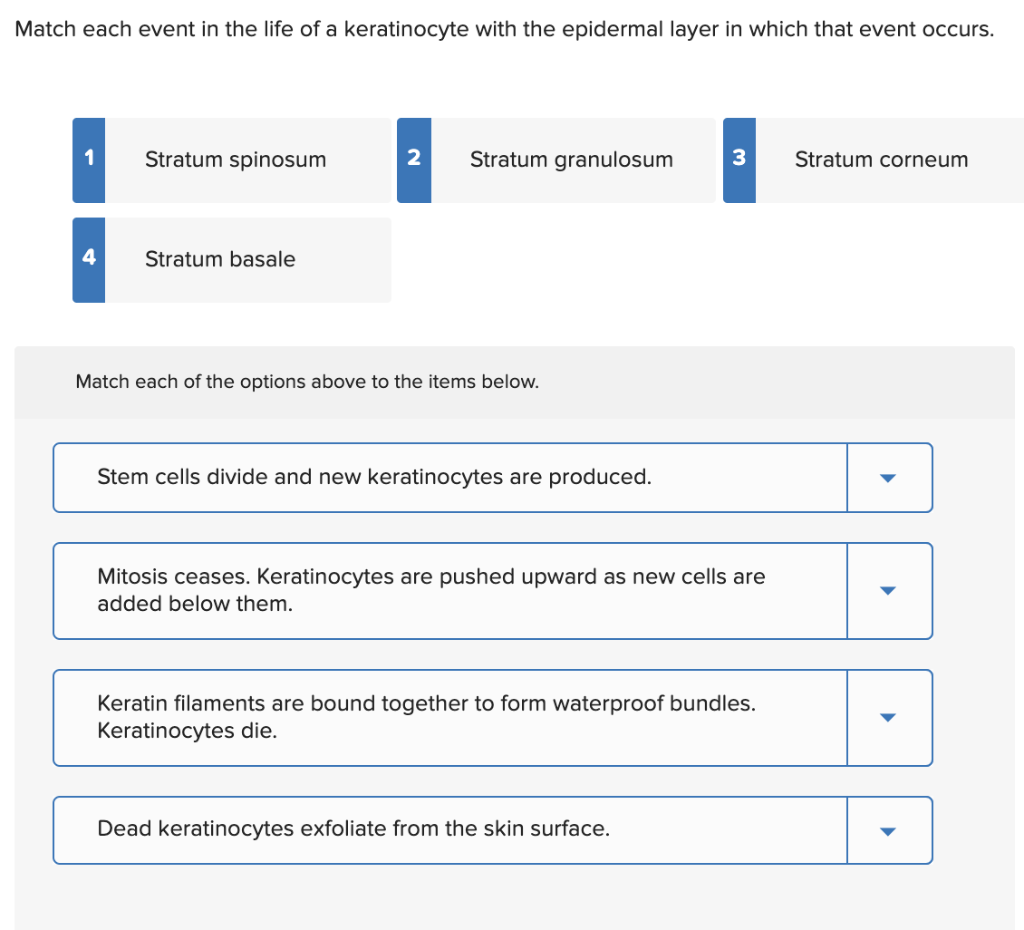We determined the effects of Phycosaccharide AI a cosmetic ingredient. During its life cycle a keratinocyte can exist as a dividing cell in the basal layer or inner most layer of the epidermis.

Solved The Following Events Occur In The Life Of A Chegg Com
However some of the keratinocytes begin to differentiate and are pushed upwards to the superficial layers of the epidermis.

. The stratum basale is a continuous layer of cells usually only one cell thick that is layered directly above the dermis. Throughout their program of differentiation keratinocytes produce a variety of keratin isoforms a protein that provides strength to skin hair and nails. Do you know the answer.
A number of these cells are stem cells but the majority are transit amplifying cells. Preparations of basal keratinocytes may be separated on the basis of size and density using Percoll gradient sedimentation. Undergo cell division to produce new keratinocytes As a new pair to know sites from SC 121 at Kaplan University.
The stratum basale is a single layer of cells primarily made of basal cells. Place them in chronological order. Stem cells form large highly proliferative colonies in vitro 4S2.
Mitosis ceases as epidermal cells are pushed upward. Epidermal stem cells reside in the lower part of the epidermis stratum basale and are attached to the basement membrane through hemidesmosomes. Epithelial stem cellscontains layers of cells called keratinocytes.
Related to the point above is the question of whether stem cells have a specific type of cell division or mitosis. Which layer has stem cells that undergo cell division to continually produce new keratinocytes. 3 Keratinocytes flatten and produce waterproof bundles of keratin filaments.
The fully cornified keratinocytes that form the outermost layer are constantly shed off and replaced by new cells. Keratinocytes are produced deep in the epidermis by the mitosis of stem cells in the stratum basale. The following events occur in the life of a keratinocyte.
2 Mitosis ceases as epidermal cells are pushed upward. The following events occur in the life of a keratinocyte. The cells that divide to form colonies in this assay defined as keratinocyte CFCs kCFCs may therefore represent the in vitro correlate of keratinocyte stem cells which retain label and persist in the epidermis.
1 Stem cells divide to produce new keratinocytes. Because we constantly lose these epidermal cells they must be continually replaced. These stem cells generate transient amplifying TA cells that terminally differentiate after a discrete number of cell divisions.
Stem cells divide to produce new keratinocytes. Keratinocytes divide in the basal to spinous layer stratum basal and stratum spinosum respectively. The keratinocytes slowly move outward through the epidermis as they mature and they eventually die and are.
On average every 28-40 days a new skin cell is produced at the deepest layer of the epidermis the stratum germinativum. Over time the these differentiating cell are pushed upwards as the next generation of cells forms underneath them. 1 Stem cells divide to produce new keratinocytes.
In 30 to 40 days a keratinocyte makes its. Some of these cells will stay with their parent and continue to replenish the population of basal keratinocytes. Keratinocytes flatten and produce waterproof bundles of keratin filaments.
3 Keratinocytes flatten and produce waterproof bundles of keratin filaments. The primary function of keratinocytes is to divide and migrate superficially to the stratum spinosum the next of the five epidermal layers. In vivo keratinocyte stem cells are usually slow-cycling and retain labeled DNA precursors whereas TA cells divide rapidly and dilute their label quickly 48.
A basal cell is a cuboidal-shaped stem cell that is. Stem cells have both the capacity to self-renew that is to divide and create additional stem cells and also to differentiate along a specified molecular pathway. It is primarily made up of basal keratinocytes the stem cells of the epidermis.
Embryonic stem cells are very nearly totipotent reserving the elite privileges of choosing among most if not all of the differentiation pathways that specify the animal. This relates to the issue of whether in steady state stem cells always divide symmetrically and differentiation or positional signals remove half of the daughters produced or whether they always divide asymmetrically and to what extent they can change. The lifecycle of the keratinocyte.
These cells are known as stem cells. However other cells will start a process of differentiation. Dead keratinocytes exfoliate from the skin surface.
These cells continuously divide to form new basal keratinocytes and are knowns as stem cells. Dead keratinocytes flake off the surface of the skin as dander. Keratin filaments are bound together to form waterproof bundles.
Keratinocytes are pushed upward as new cells are added below them. Eventually they are pushed into the next layer of the skin to. INCI name Hydrolyzed align CODIF International France on the number of large highly proliferative colonies produced by aged human keratinocytes in vitro.
Various crosslinking proteins such as transglutaminase are also produced in the. Only the basal layer next to the dermis contains cells that divide. 2 Mitosis ceases as epidermal cells are pushed upward.
Stem cells of keratinocytes are found in the epidermal basal layer which is the innermost layer of stratified epithelia. Stem cells divide and new keratinocytes are produced. I know it Think so Unsure No idea Type your answer in the box.

Solved Match Each Event In The Life Of A Keratinocyte With Chegg Com

The Life Cycle Of A Keratinocyte Mitosis Of Stem Cells In The Stratum Basale Produce Keratinocytes Deep In The Epide Skin Science Mitosis Integumentary System
Keratinocytes Their Purpose Their Subtypes And Their Lifecycle Tempo Bioscience
0 Comments